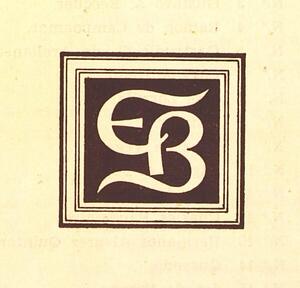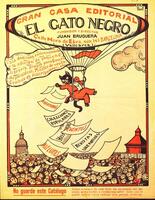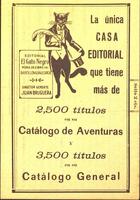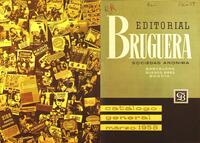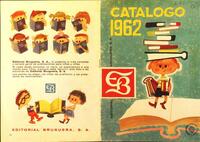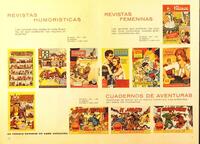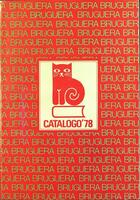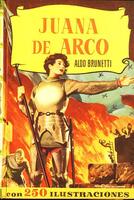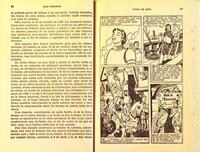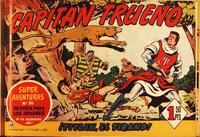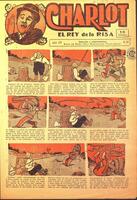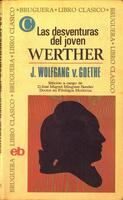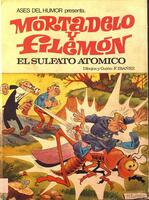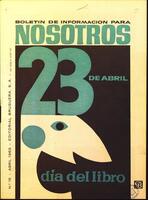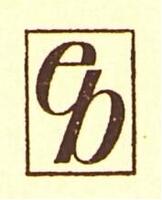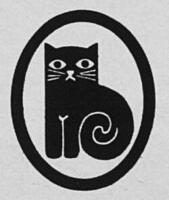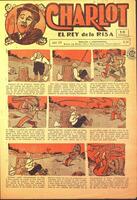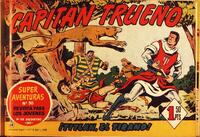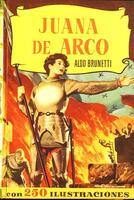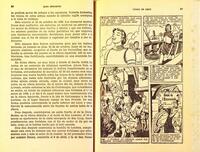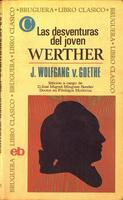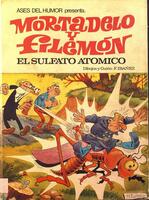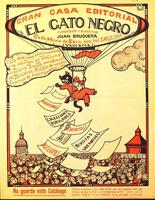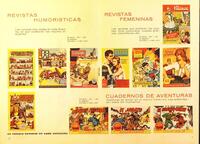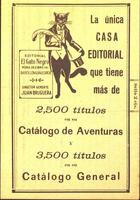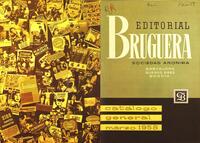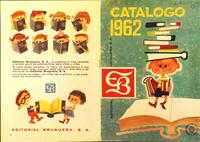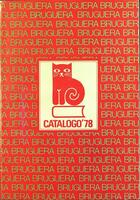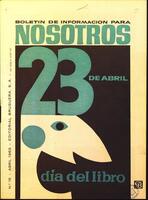Bruguera
(Updated 08/10/2024)
In 1910, Joan Bruguera Teixidó founded the Bruguera publishing house, which was initially called El Gato Negro. From the very start, it focused on popular literature which it issued regularly at affordable prices. By 1938, it had published thousands of titles, including literary classics from all over the world, books of jokes, comics and children’s stories and especially serial novels. It published all kinds of genres: adventure books, police stories, humorous books, war stories, historical novels, mysteries, but also transfers, picture cards and cut-outs. In 1921, the magazine Pulgarcito was launched, the most popular periodical of the many titles that the publishing house issued until 1939. Sigronet was launched in Catalan in 1924 under editor-in-chief, Emili Graells.
In 1940, Pantaleón and Francisco Bruguera, the sons of the founder, who had died in 1933, decided to change the name of the publishing house to use the family’s surname. The restrictions on paper, rigid censorship and favourable treatment for children’s magazines that supported the Franco regime were complicating factors at the onset of this new era.
+ informationSearch collections
Bruguera collection at the a la Biblioteca Jaume Fuster (Jaume Fuster Library)
Catalogue of publishers and booksellers from the Bergnes de las Casas collection (Biblioteca de Catalunya)
Catalogue of publishers of Catalonia (Biblioteca de Catalunya)
More information and documentation on the works produced
Guiral, Antoni. 100 años de Bruguera: de El Gato Negro a Ediciones B. Barcelona [etc.]: Ediciones B, Grupo Zeta, DL 2010.
Llanas, Manuel. L’edició a Catalunya. Segle XX (fins a 1939). Barcelona: Gremi d’Editors de Catalunya, 2005.
Llanas, Manuel. L’edició a Catalunya. Segle XX (1939-1975). Barcelona: Gremi d’Editors de Catalunya, 2005.
Bruguera
Description
In 1910, Joan Bruguera Teixidó founded the Bruguera publishing house, which was initially called El Gato Negro. From the very start, it focused on popular literature which it issued regularly at affordable prices. By 1938, it had published thousands of titles, including literary classics from all over the world, books of jokes, comics and children’s stories and especially serial novels. It published all kinds of genres: adventure books, police stories, humorous books, war stories, historical novels, mysteries, but also transfers, picture cards and cut-outs. In 1921, the magazine Pulgarcito was launched, the most popular periodical of the many titles that the publishing house issued until 1939. Sigronet was launched in Catalan in 1924 under editor-in-chief, Emili Graells.
In 1940, Pantaleón and Francisco Bruguera, the sons of the founder, who had died in 1933, decided to change the name of the publishing house to use the family’s surname. The restrictions on paper, rigid censorship and favourable treatment for children’s magazines that supported the Franco regime were complicating factors at the onset of this new era.
In 1947, regular publication of a new Pulgarcito got underway, as well as other humorous comic magazines (El DDT), collections of popular novels (Corín Tellado with sentimental novels and Marcial Lafuente Estefanía with westerns were among the most popular) and adventure comics (El Capitán Trueno, El cachorro). Other emblematic collections were Zipi y Zape and Mortadelo y Filemón.
In the mid-1950s, the publishing house experienced heavy growth and over time became a publishing multinational with a presence in several different Latin American countries. In the second half of the 1950s, its popular literature collection Bolsilibros and its Joyas Literarias, which published literary classics from all over the world (Charles Dickens, Victor Hugo and Herman Melville) became wildly popular, along with bestsellers from the era: Leon Uris’ Éxodo (Exodus) was a huge seller. In the 1960s, it launched a line of publications in Catalan.
In the 1960s, its expansion continued as it multiplied the number of magazines it published. However, it did so somewhat carelessly, and because of both internal and external causes, the company ended up filing a suspension of payments in 1982 and closed permanently in 1986. That same year, Grupo Zeta purchased the entire Bruguera collection and transformed it into Edicions B, thus entering the business of literature, essays and comics.
In 2006, Bruguera was relaunched as a small publishing imprint within Edicions B under the management of Anna Maria Moix, although it was permanently shuttered in 2010.
Other logos of the publishing house.
Bruguera
Authors
Hundreds of authors of all eras were published in the imprint’s different collections, both literary classics from around the world and contemporary authors. They were all published primarily in pocket editions. There were also numerous writers who penned the texts of the periodicals.
Alighieri, Dante, 1265- 1321
Baroja, Pío, 1872-1956
Borges, Jorge Luis, 1899-1986
Calderón de la Barca, Pedro, 1600-1681
Dickens, Charles, 1812-1870
Flaubert, Gustave, 1821-1880
Goethe, Johann Wolfgang von, 1749-1832
Lee, Harper, 1926-
Mora, Víctor, 1931-2016
Stendhal, 1783-1842
Tolstoi, Lev, graf, 1828-1910
Twain, Mark, 1835-1910
Uris, Leon, 1924-2003
Verne, Jules, 1828-1905
Bruguera
Illustrators and photographers
Throughout the lifespan of the publishing house, dozens and dozens of illustrated magazines popularised a host of characters that were created by countless writers and illustrators, some of whom shaped what is called the Escola Bruguera (Bruguera School).
Bruguera
Outstanding works
-
El Gato Negro, the predecessor of Bruguera, published numerous children’s magazines, including Charlot, taking advantage of the popularity of this film character.
Charlot: el rey de la risa. Barcelona: Gato Negro, [1928-193-?]
-
Capitán Trueno was one of Bruguera’s most popular comic book characters and a huge bestseller, with print runs of up to 350,000 copies.
Capitán Trueno. [Barcelona: Bruguera, 1958-1968].
-
Cover and sample illustrated text from Juana de Arco (Joan of Arc), the first title from Historias, a collection whose texts were illustrated with drawings to make for easier reading for a young audience.
Brunetti, Aldo. Juana de Arco. Barcelona [etc.]: Bruguera, 1958.
-
The works published in the Libro Clásico collection included a preliminary study of the work and the author, notes and a bibliography, in editions meant primarily for scholars and experts.
Goethe, Johann Wolfgang von. Las desventuras del joven Werther. Barcelona [etc.]: Bruguera, 1968.
-
The first title from the Ases del Humor collection with the characters Mortadelo and Filemón, some of the most popular from Bruguera’s comics.
Ibáñez F. El sulfato atómico. Barcelona [etc.]: Bruguera, DL 1969.
- The cover of a catalogue from the El Gato Negro publishing house, Bruguera’s first name, with comics, romances and children’s publications, which illustrate the popular nature of the publications it issued.
- Inside pages of a Bruguera catalogue from 1962, which offered full-colour advertisement of some of the publishing house’s most popular and bestselling magazines.
- El Gato Negro order form and Bruguera catalogues from different periods.
- Internal Bruguera newsletter, with drawings and photographs, which included gossip, jokes and all kinds of news of interest to its employees.
